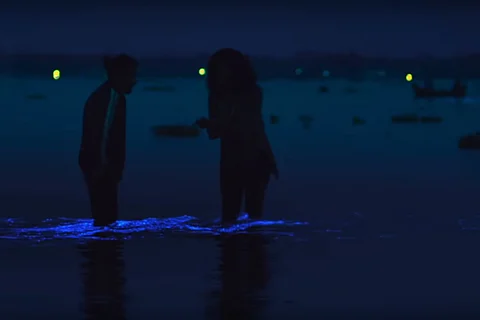

“The water is ‘blooming’ with sea sparkles. Why don’t you take her out and show it to her?” (Kavaru adichu kidakkanu, kondoyi kanikkan padille?) Bobby (Shane Nigam) asks his brother Bonny (Sreenath Bhasi), indicating the magical glow in the waters in Kumbalangi Nights.
The scene that follows, along with the music, definitely has us enthralled by the beauty of Kumbalangi, the chemistry between Bonny and Nylah (Jasmine Metivier), and the surrealistic glow in the water they are playing in.
Kumbalangi Nights, the most talked about Malayalam movie currently, narrates the life of four brothers in the island village of Kumbalangi in Kochi. The film is said to have showcased brilliance in most aspects of filmmaking – acting, cinematography, music, and is rated highly.
Many who saw the movie have been wondering and asking each other what ‘kavaru’ (colloquial term for sea sparkle) is all about and how the phenomenon happens.
Madhu C Narayanan, the director of Kumbalangi Nights, explained that ‘kavaru’ is bioluminescence, popularly known as sea sparkle, sighted along coasts, estuaries and brackish waters.
“Though I have not seen sea sparkles personally, many in my crew and friends, including the dancers from Kumbalangi, have sighted it many a times in their lives. Most people living along Vypin and Cherayi have experienced it. One of my friends named Eldo had even photographed the bioluminescence thoroughly when he was in Edavanakkad a couple of years ago,” Madhu told TNM.
“People who live in close contact with the brackish waters, like the ‘brothers’ in Kumbalangi, have experienced it. In the movie, we recreated the sea sparkles effect for the sequence with the help Mindstein Studios, a VFX firm based in Chennai. It is obviously visual effects in the film and not a natural occurrence,” he chuckled. Madhu went on to say, “The phenomenon does happen in Kerala, though not many of us are aware of it.”
Dr Gulshad Mohammed, Principal Marine Scientist, Central Marine and Fisheries Research Institute (CMFRI), Kozhikode, who has presented a paper on the sparkling red waves, agrees with Madhu.
Throwing more light to the ‘magical glow’ phenomenon, Dr Gulshad said, “Sea sparkle, as the name suggests, is caused by high concentration of a micro-plankton called Noctiluca scintillans in the sea. The sparkle can be compared to the fireflies’ glow, but the micro-plankton itself cannot be seen by the naked eye as it’s a micro-organism. Though pretty rare, bioluminescence may also be sighted in estuaries and brackish waters where sea water intrusion happens. It is more common in Japan, California in the US and in South American coasts. It is rarely sighted in our coasts, perhaps due to the tidal amplitude. Tidal amplitude disturbs the concentration. For the glow to be visible, there should be a very high concentration, with millions of the particular plankton species coming together. This happens in relatively calm waters and in a highly conducive environment. As the life cycle of Noctiluca is just about a day, the sighting would also last only for a few hours or a day.”
“The months of September and October, post the rains, when the sea is rich after the flushing out from the land is said to be a bloom period for the planktons. That is mostly when the red waves are also sighted, another similar phenomenon in which the waves are illuminated, with a red hue to them. Sea sparkle is also likely to happen during these months. But it is always a may or may not happen phenomenon,” said Dr Gulshad, pointing to the uncertainty.
Planktons are the primary food source for fishes, mussels, prawns and the like. One variety of the Noctiluca scintillans plankton species is also poisonous, the marine scientist said.
A CG artist, who worked along with the team at Mindstein Studios, sharing his experience on recreating the sea sparkle effects, said, “After the film’s crew gave a reference to the sea sparkles and approved our test work on the same, we started working on the different elements of the whole sequence, like dynamic effects, pyrotechnics, simulation, and finally composited it to what is now seen in the movie.”